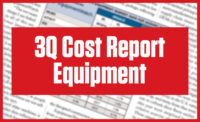Caterpillar is focusing its CONEXPO presentation on demonstrating a remotely operated dozer and its expanded telematics reporting, but is also dealing with the fallout from a raid by IRS and Commerce Dept. agents of its Peoria, Ill. headquarters on March 2.
The ongoing federal investigation stems from a 2009 lawsuit by former Cat executive Daniel Schlicksup, who claims he was unfairly demoted after blowing the whistle on an alleged effort by the company to shift profits from a U.S.-based facility to a Swiss subsidiary with a lower tax rate. Schlicksup claims that this tactic allowed Caterpillar to avoid paying more than $2 billion in federal income taxes. Caterpillar said in a statement that it is cooperating with federal investigators. Cat spokespersons declined to comment to ENR about the incident.
"We are cooperating and we will continue to do that in good faith and as a good corporate citizen," Cat CEO Jim Umpleby said during a press conference on March 7. In response to reporters' questions about Cat's global tax strategies, Umpleby said that "we continually evaluate our policies to make sure we are complying with all applicable laws and regulations wherever we operate in the world. It would be too early for me to speculate, other than that. We take our responsibility very seriously in complying with laws around the world."
Meanwhile, at the triennial CONEXPO-CON/AGG equipment show in Las Vegas held March 7-11, Caterpillar says it is shifting away from development of "blue-sky" technologies in favor of improving utilization rates among its customers of telematics, machine controls and other existing technologies.
“The utilization of technology in this industry is still very low,” observes Paolo Fellin, Cat vice president for global construction and infrastructure. “We need to show that this technology can have a significant impact.”
According to Fellin, adoption among equipment fleets for telematics systems like Cat Connect are currently at about 15% to 20%. Cat’s latest focus is to grow that share to a telematics utilization rate of 30% to 40%.
One of the hands-on displays Cat will have at the show is the Cat Command for Dozers, which allows for remote operation of its D8T dozer across great distances. Attendees to CONEXPO in Las Vegas will be able to hop in the driver’s seat of a D8T dozer at Cat’s proving ground near Peoria, Ill., and run the machine with little noticeable lag. According to Cat, the system requires only a standard internet connection, and the remote-control package can come installed on the dozer from the factory.
Cat’s remote operation also can be used on-site using a portable control panel that works as long as line-of-sight is maintained with the machine.
According to Cat, remote operation isn’t intended to replace traditional operators, but is rather a way technology can aid them when it’s too hazardous or impractical for normal operation. Existing technological solutions like these are low-hanging fruit, says Fellin, and increasing their usage is Cat’s goal right now. “We had made a conscious decision to invest in cutting-edge technology, but the usage of that technology is still low,” he says. “Now we need to make sure that the customer is aware that these technologies can lead to real gains in productivity.”
This article was updated on March 7 to reflect new comments from Caterpillar CEO Jim Umpleby.







